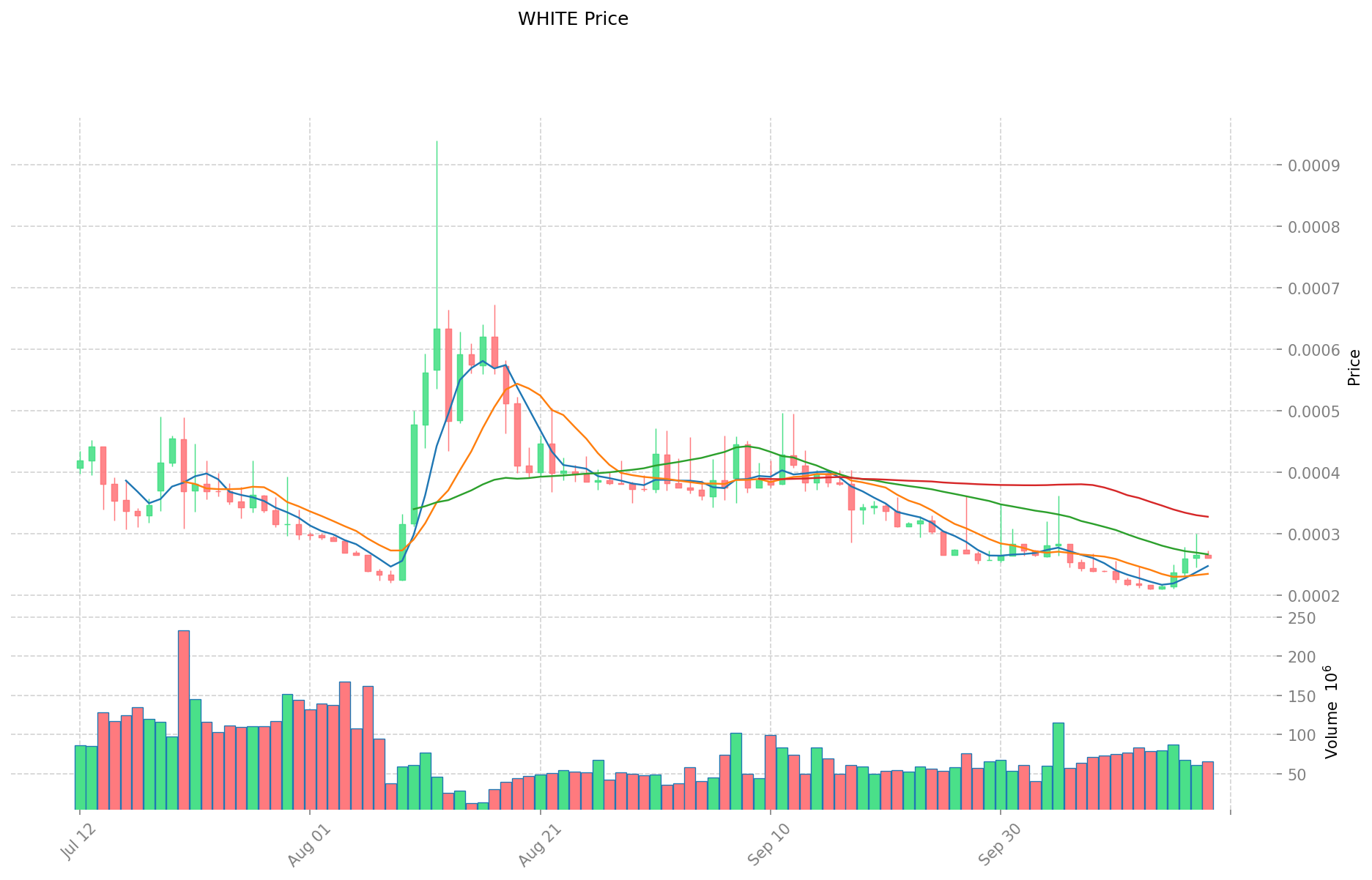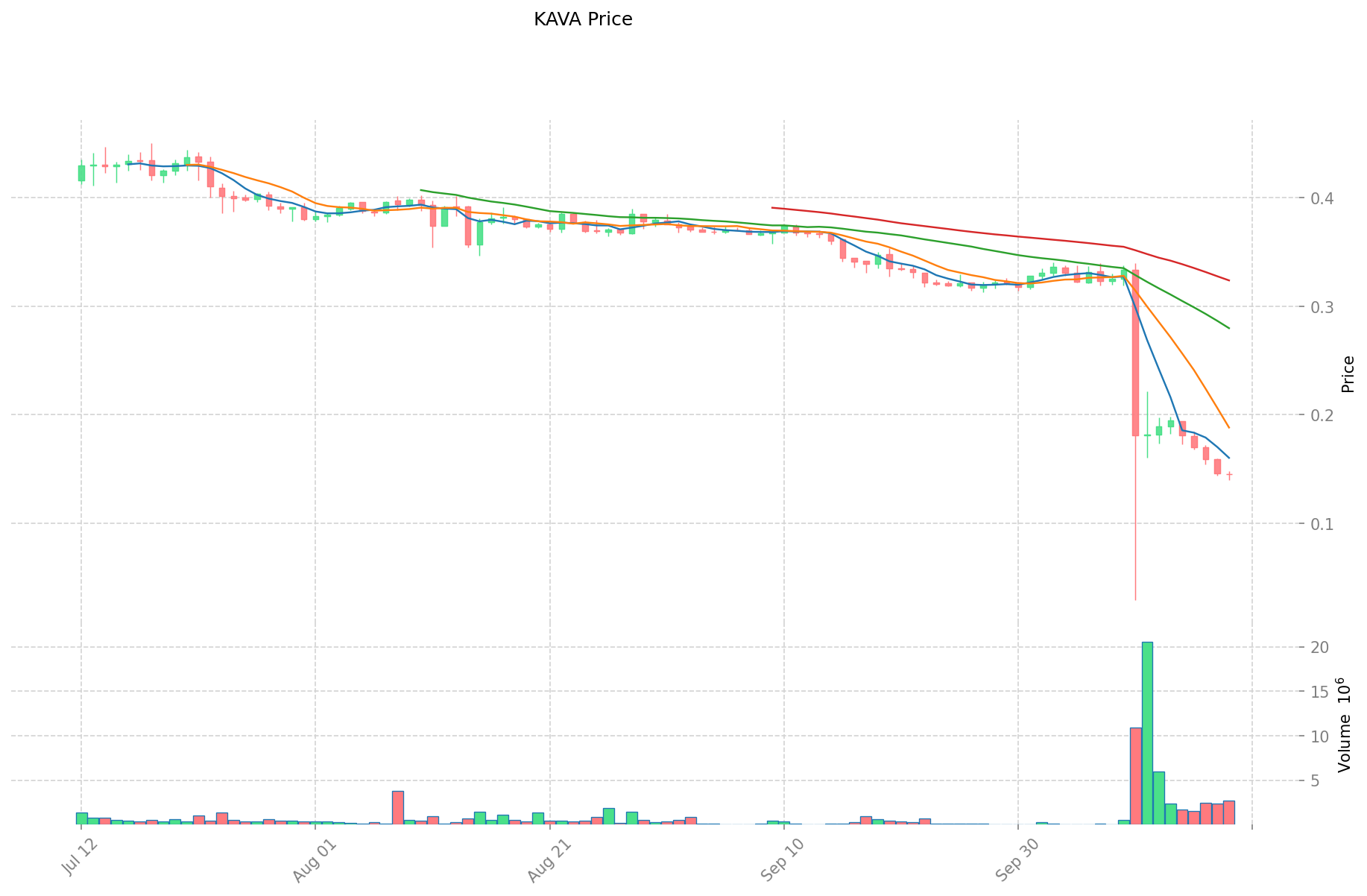WHITE vs KAVA: A Battle of Crypto Titans in the Decentralized Finance Arena
Introduction: Investment Comparison of WHITE vs KAVA
In the cryptocurrency market, the comparison between WhiteRock (WHITE) and Kava (KAVA) has been an unavoidable topic for investors. The two not only show significant differences in market cap ranking, application scenarios, and price performance but also represent different positions in the crypto asset landscape.
WhiteRock (WHITE): Launched in 2025, it has gained market recognition for its role in tokenizing traditional financial assets.
Kava (KAVA): Introduced in 2019, it has been hailed as a cross-chain DeFi platform, becoming one of the notable players in the decentralized finance space.
This article will comprehensively analyze the investment value comparison between WHITE and KAVA, focusing on historical price trends, supply mechanisms, institutional adoption, technological ecosystems, and future predictions, attempting to answer the question most crucial to investors:
"Which is the better buy right now?"
I. Price History Comparison and Current Market Status
WhiteRock (WHITE) and Kava (KAVA) Historical Price Trends
- 2025: WHITE reached its all-time high of $0.0027701 on May 29, 2025.
- 2025: KAVA hit its all-time low of $0.138058 on October 11, 2025.
- Comparative Analysis: In recent market cycles, WHITE has shown significant volatility, ranging from $0.0027701 to $0.0002088, while KAVA has experienced a substantial decline from its all-time high of $9.12 to its current price.
Current Market Situation (2025-10-19)
- WHITE current price: $0.0002606
- KAVA current price: $0.14523
- 24-hour trading volume: WHITE $17,297.31 vs KAVA $393,941.23
- Market Sentiment Index (Fear & Greed Index): 23 (Extreme Fear)
Click to view real-time prices:
- Check WHITE current price Market Price
- Check KAVA current price Market Price


II. Core Factors Affecting Investment Value of WHITE vs KAVA
Supply Mechanisms Comparison (Tokenomics)
-
WHITE: Fixed maximum supply of 100 million tokens with deflationary mechanisms through token burns during transactions
-
KAVA: Initial supply of 127 million with annual inflation between 3-20% based on bonded tokens, using a hybrid inflationary model
-
📌 Historical Pattern: Deflationary tokens like WHITE tend to gain value over time as supply diminishes, while KAVA's controlled inflation model supports network security but may create selling pressure.
Institutional Adoption and Market Applications
- Institutional Holdings: KAVA has gained more institutional traction with partnerships across traditional finance and backing from major validators
- Enterprise Adoption: KAVA shows stronger enterprise integration through its interoperability focus and cross-chain payment solutions, while WHITE primarily serves its own ecosystem
- National Policies: Both face similar regulatory challenges in major jurisdictions, though KAVA's positioning as infrastructure may provide regulatory advantages
Technical Development and Ecosystem Building
- WHITE Technical Upgrades: Focus on scalability improvements and enhanced privacy features while maintaining core functionality
- KAVA Technical Development: Continuing to expand cross-chain capabilities, enhancing its Layer-1 throughput, and implementing the Cosmos IBC protocol
- Ecosystem Comparison: KAVA has more developed DeFi applications including lending, borrowing and yield farming, while WHITE has stronger focus on payment solutions and basic token transfers
Macroeconomic Factors and Market Cycles
- Performance in Inflationary Environments: WHITE's fixed supply model theoretically provides better inflation hedging properties
- Macroeconomic Monetary Policy: Both tokens show correlation to risk assets, with interest rate increases negatively affecting prices
- Geopolitical Factors: KAVA's cross-chain infrastructure provides utility during periods of geopolitical uncertainty and cross-border transaction needs
III. 2025-2030 Price Prediction: WHITE vs KAVA
Short-term Prediction (2025)
- WHITE: Conservative $0.000164115 - $0.0002605 | Optimistic $0.0002605 - $0.000388145
- KAVA: Conservative $0.0839956 - $0.14482 | Optimistic $0.14482 - $0.1506128
Mid-term Prediction (2027)
- WHITE may enter a growth phase, expected price range $0.00024359862975 - $0.000457570399125
- KAVA may enter a steady growth phase, expected price range $0.14355079752 - $0.18861907116
- Key drivers: Institutional capital inflow, ETF, ecosystem development
Long-term Prediction (2030)
- WHITE: Base scenario $0.000328059093986 - $0.000512592334354 | Optimistic scenario $0.000512592334354 - $0.000604858954538
- KAVA: Base scenario $0.213109838734104 - $0.23678870970456 | Optimistic scenario $0.23678870970456 - $0.262835467772061
Disclaimer: The above predictions are based on historical data and market analysis. Cryptocurrency markets are highly volatile and subject to change. This information should not be considered as financial advice. Always conduct your own research before making investment decisions.
WHITE:
| 年份 | 预测最高价 | 预测平均价格 | 预测最低价 | 涨跌幅 |
|---|---|---|---|---|
| 2025 | 0.000388145 | 0.0002605 | 0.000164115 | 0 |
| 2026 | 0.000334052175 | 0.0003243225 | 0.00030486315 | 24 |
| 2027 | 0.000457570399125 | 0.0003291873375 | 0.00024359862975 | 26 |
| 2028 | 0.000542862838271 | 0.000393378868312 | 0.000212424588888 | 50 |
| 2029 | 0.000557063815417 | 0.000468120853291 | 0.000351090639968 | 79 |
| 2030 | 0.000604858954538 | 0.000512592334354 | 0.000328059093986 | 96 |
KAVA:
| 年份 | 预测最高价 | 预测平均价格 | 预测最低价 | 涨跌幅 |
|---|---|---|---|---|
| 2025 | 0.1506128 | 0.14482 | 0.0839956 | 0 |
| 2026 | 0.186122664 | 0.1477164 | 0.109310136 | 1 |
| 2027 | 0.18861907116 | 0.166919532 | 0.14355079752 | 14 |
| 2028 | 0.248877022212 | 0.17776930158 | 0.1653254504694 | 22 |
| 2029 | 0.26025425751312 | 0.213323161896 | 0.14505975008928 | 46 |
| 2030 | 0.262835467772061 | 0.23678870970456 | 0.213109838734104 | 63 |
IV. Investment Strategy Comparison: WHITE vs KAVA
Long-term vs Short-term Investment Strategy
- WHITE: Suitable for investors focused on asset tokenization and deflationary mechanisms
- KAVA: Suitable for investors interested in DeFi ecosystems and cross-chain functionality
Risk Management and Asset Allocation
- Conservative investors: WHITE: 30% vs KAVA: 70%
- Aggressive investors: WHITE: 60% vs KAVA: 40%
- Hedging tools: Stablecoin allocation, options, cross-currency portfolios
V. Potential Risk Comparison
Market Risk
- WHITE: High volatility due to lower market cap and trading volume
- KAVA: Susceptible to broader DeFi market trends and competition
Technical Risk
- WHITE: Scalability, network stability
- KAVA: Interoperability challenges, smart contract vulnerabilities
Regulatory Risk
- Global regulatory policies may impact both, with KAVA potentially facing more scrutiny due to its DeFi focus
VI. Conclusion: Which Is the Better Buy?
📌 Investment Value Summary:
- WHITE advantages: Deflationary model, potential for asset tokenization growth
- KAVA advantages: Established DeFi ecosystem, cross-chain capabilities
✅ Investment Advice:
- New investors: Consider a balanced approach with a slight preference for KAVA due to its more established ecosystem
- Experienced investors: Explore WHITE for its growth potential while maintaining a position in KAVA
- Institutional investors: Evaluate KAVA for its institutional partnerships and DeFi infrastructure potential
⚠️ Risk Warning: Cryptocurrency markets are highly volatile, and this article does not constitute investment advice. None
VII. FAQ
Q1: What are the main differences between WHITE and KAVA? A: WHITE is a newer token focused on tokenizing traditional financial assets, with a fixed supply and deflationary mechanism. KAVA is an established cross-chain DeFi platform with a larger ecosystem and controlled inflationary model.
Q2: Which token has shown better price performance recently? A: KAVA has shown more stability in recent market cycles, while WHITE has experienced significant volatility. As of October 19, 2025, WHITE's price is $0.0002606, and KAVA's price is $0.14523.
Q3: How do the supply mechanisms of WHITE and KAVA differ? A: WHITE has a fixed maximum supply of 100 million tokens with deflationary mechanisms through token burns. KAVA has an initial supply of 127 million with annual inflation between 3-20% based on bonded tokens.
Q4: Which token has better institutional adoption? A: KAVA has gained more institutional traction with partnerships across traditional finance and backing from major validators. It also shows stronger enterprise integration through its interoperability focus and cross-chain payment solutions.
Q5: What are the long-term price predictions for WHITE and KAVA? A: By 2030, WHITE's base scenario price range is predicted to be $0.000328059093986 - $0.000512592334354, while KAVA's base scenario range is $0.213109838734104 - $0.23678870970456.
Q6: How should investors allocate their portfolio between WHITE and KAVA? A: Conservative investors might consider allocating 30% to WHITE and 70% to KAVA, while aggressive investors might opt for 60% WHITE and 40% KAVA. However, individual circumstances may vary, and this is not financial advice.
Q7: What are the main risks associated with investing in WHITE and KAVA? A: Both tokens face market risks, with WHITE experiencing higher volatility due to its lower market cap. Technical risks include scalability issues for WHITE and interoperability challenges for KAVA. Regulatory risks are present for both, with KAVA potentially facing more scrutiny due to its DeFi focus.
Share
Content